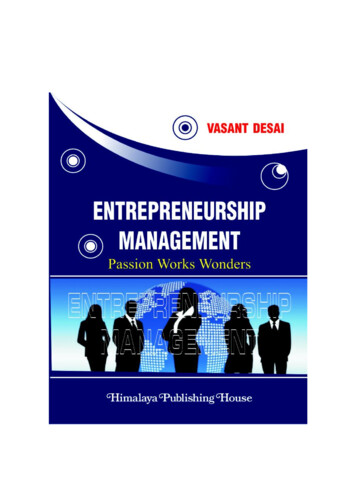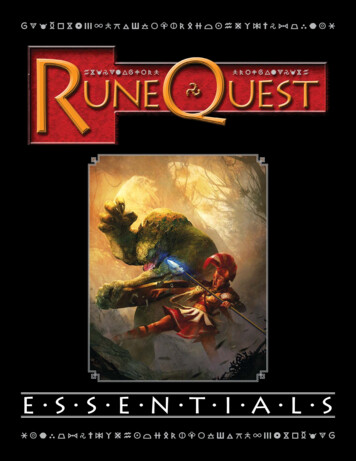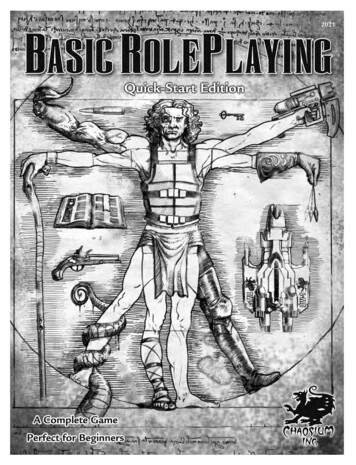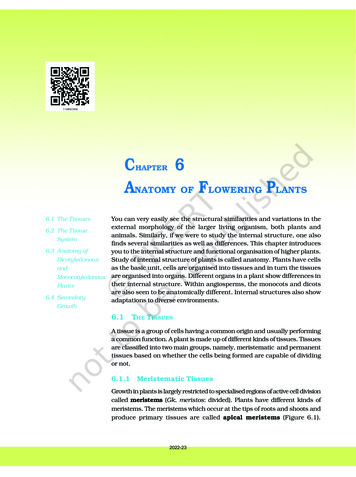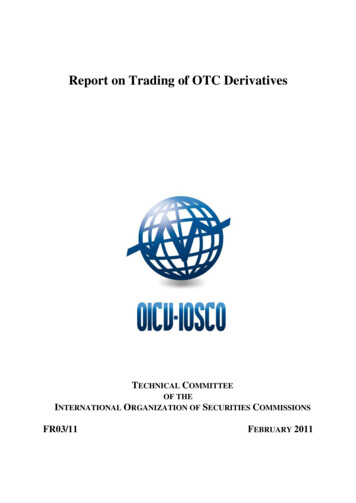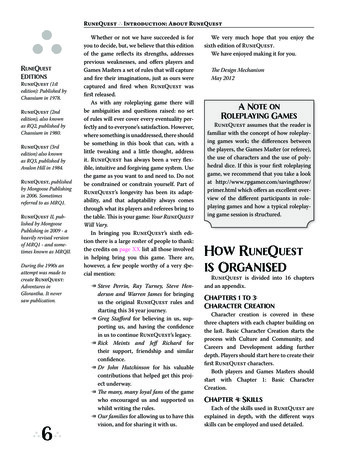
Transcription
%RuneQuestEditionsRuneQuest (1stedition): Published byChaosium in 1978.RuneQuest (2ndedition), also knownas RQ2, published byChaosium in 1980.RuneQuest (3rdedition) also knownas RQ3, published byAvalon Hill in 1984.RuneQuest, publishedby Mongoose Publishingin 2006. Sometimesreferred to as MRQ1.RuneQuest II, published by MongoosePublishing in 2009 - aheavily revised versionof MRQ1 - and sometimes known as MRQII.During the 1990s anattempt was made tocreate RuneQuest:Adventures inGlorantha. It neversaw publication.%6%RuneQuest % Introduction: About RuneQuestWhether or not we have succeeded is foryou to decide, but, we believe that this editionof the game reflects its strengths, addressesprevious weaknesses, and offers players andGames Masters a set of rules that will captureand fire their imaginations, just as ours werecaptured and fired when RuneQuest wasfirst released.As with any roleplaying game there willbe ambiguities and questions raised: no setof rules will ever cover every eventuality perfectly and to everyone’s satisfaction. However,where something is unaddressed, there shouldbe something in this book that can, with alittle tweaking and a little thought, addressit. RuneQuest has always been a very flexible, intuitive and forgiving game system. Usethe game as you want to and need to. Do notbe constrained or constrain yourself. Part ofRuneQuest’s longevity has been its adaptability, and that adaptability always comesthrough what its players and referees bring tothe table. This is your game: Your RuneQuestWill Vary.In bringing you RuneQuest’s sixth edition there is a large roster of people to thank:the credits on page XX list all those involvedin helping bring you this game. There are,however, a few people worthy of a very special mention:҉҉Steve Perrin, Ray Turney, Steve Henderson and Warren James for bringingus the original RuneQuest rules andstarting this 34 year journey.҉҉Greg Stafford for believing in us, supporting us, and having the confidencein us to continue RuneQuest’s legacy.҉҉Rick Meints and Jeff Richard fortheir support, friendship and similarconfidence.҉҉Dr John Hutchinson for his valuablecontributions that helped get this project underway.҉҉The many, many loyal fans of the gamewho encouraged us and supported uswhilst writing the rules.҉҉Our families for allowing us to have thisvision, and for sharing it with us.We very much hope that you enjoy thesixth edition of RuneQuest.We have enjoyed making it for you.The Design MechanismMay 2012A Note onRoleplaying GamesRuneQuest assumes that the reader isfamiliar with the concept of how roleplaying games work; the differences betweenthe players, the Games Master (or referee),the use of characters and the use of polyhedral dice. If this is your first roleplayinggame, we recommend that you take a lookat http://www.rpgamer.com/savingthrow/primer.html which offers an excellent overview of the different participants in roleplaying games and how a typical roleplaying game session is structured.How RuneQuestis OrganisedRuneQuest is divided into 16 chaptersand an appendix.Chapters 1 to 3:Character CreationCharacter creation is covered in thesethree chapters with each chapter building onthe last. Basic Character Creation starts theprocess with Culture and Community, andCareers and Development adding furtherdepth. Players should start here to create theirfirst RuneQuest characters.Both players and Games Masters shouldstart with Chapter 1: Basic CharacterCreation.Chapter 4: SkillsEach of the skills used in RuneQuest areexplained in depth, with the different waysskills can be employed and used detailed.
RuneQuest % Introduction: About RuneQuestChapter 5: Economicsand EquipmentThis chapter looks at the use of moneyand social class in RuneQuest, examiningincome, its use and different social levels inRuneQuest’s cultures. All manner of adventuring equipment, from armour and weapons, through to tools and vehicles, are thendescribed. This chapter also includes rules forbuilding and repairing items.Chapter 6: MechanicsRules for a myriad of different situationsare covered here, including rules for characterexperience, advancement and training.Chapter 7: CombatFighting – close combat and ranged – isthis chapter’s focus. It describes how combats work, need to be run, the use of SpecialEffects and other combat techniques.Chapter 8: MagicThis is the introductory chapter for RuneQuest’s five different magic systems. Itexplores the runes – what they are and howthey work – and the fundamentals of magicin its different forms. The chapter offers suggestions and advice on structuring magic ina RuneQuest campaign, and how to gain,manage and restore magic points.Chapters 9, 10, 11, 12 and13: Magic SystemsFolk Magic, Animism, Mysticism, Theismand Sorcery are the different magic systemsRuneQuest uses, each with its own chapter.The various differences are explained and thepowers offered by the magic system explored.Chapter 14: Cults andBrotherhoodsReligious organisations and other kindsof societies are detailed in this chapter. Cultshave been an important and traditional partof RuneQuest, and they are covered in significant detail along with templates for manydifferent kinds of cult, order, school and so onfor Games Masters and Players to build uponfor their own campaigns.Chapter 15: CreaturesInsects, mammals, fish and monsters frommyth and legend are this chapter’s focus. Aswell as providing statistical entries for wellover 50 creatures, extensive notes are given onhow to use creatures in RuneQuest games,including using different races as player characters and designing your own creatures.%Chapter 16: Games MasteryThis chapter offers copious notes, thoughtsand guidance on how to Games Master RuneQuest games. Areas for consideration aresummarised, options explored, and differentways of using the rules offered. An invaluablechapter for new and old RuneQuest GamesMasters alike.AppendixThe appendices include all the most commonly used charts and tables for easy reference. We also include a sample charactersheet for use in RuneQuest games. Theappendices are also available as a free download from the Design Mechanism website.Glossary of TermsMany different terms and phrases are usedthroughout RuneQuest to denote certainfeatures, functions and game effects. A glossary of the most frequent and importantfollows:Attributes:Game abilities derived from one of moreCharacteristics: Action Points, Hit Points,Magic Points and so forth.Characteristic:One of seven identifiers used in charactercreation: Strength, Constitution, Size and soon.Combat Round:A period of five seconds and used to measure the detailed activities during combat.Cycle:The sequence in which all characters act, inTurns, during a Combat Round.%7%
jAnathaym'sSagaThe cover of this bookshows a female warrior,Anathaym, battlingfor her life againsta creature intent onkilling her. ThroughoutRuneQuest we’llbe using Anathaymas an example of acharacter and, throughher, showing how theRuneQuest rules work.Her saga begins here,with character creation.Emma, the player,is creating her firstRuneQuest characterand has already decidedthat she will call herAnathaym. Emma'sGames Master, Steve,has told all the playersthat his RuneQuestcampaign will be set ina fantasy world basedheavily on ancientGreece, so Emma andher fellow players, Dave,Colin and Jo, know a little about the world theircharacters will inhabitand how to picture it.RuneQuest j chapter 1: Basic Character CreationCharacter ConceptA good place to start is to have some ideaof what sort of character you want to play; ahardened warrior for example, or a cunningthief. Your character concept does not needto be elaborate at this stage; simply an ideathat will help guide certain choices such asrace and profession. A few character ideas arelisted to provoke your imagination.҉҉Fierce barbarian hunter҉҉Young, naïve wizard҉҉Bad-tempered gemstone miner҉҉Chivalrous, yet disgraced champion҉҉Suspicious, spirit worshiping shaman҉҉Overly curious explorer-scholar҉҉Unscrupulous mercenaryNon-Human SpeciesHumans are the easiest characters to playand are probably the most common racefound in most RuneQuest campaigns, butone need not be confined to just humans. Itis possible to play just about any sapient species because all creatures, regardless of type,are defined in the same way. The Creatureschapter offers a number of alternatives alongwith detailed character creation options fornon-human species. However, if this is yourfirst RuneQuest character, stick with therules for humans given in this chapter beforebranching out into something more exotic.CharacteristicsEvery sapient creature, be it human, elderrace or monster, is defined by seven characteristics. Each characteristic tells you something about your character; how strong or fasthe or she is; how clever or healthy. Characteristics are at the core of every RuneQuestcharacter and form the basis for most of theother elements such as Attributes and Skills.The seven characteristics are:҉҉Strength (STR)҉҉Constitution (CON)҉҉Size (SIZ)҉҉Dexterity (DEX)҉҉Intelligence (INT)҉҉Power (POW)҉҉Charisma (CHA)Before calculating the characteristics,the following section explains what eachrepresents.Strength (STR)j10jSTR represents physical strength; howmuch one can lift, how hard one can hit, andso on. Characters with a high STR are likelyto be more heavily muscled whilst those witha low STR are somewhat on the scrawny side.STR is a component of the Damage Modifier (see page XX). If a character is reducedto zero STR he lacks the ability to move orlift objects, becoming bedridden until STR
RuneQuest j chapter 1: Basic Character Creationimproves somehow (through natural healingor magic, for example).Constitution (CON)CON is measure of health and hardiness.Those with a high CON are physically toughand likely to be more resistant to disease orpoison. Those with a low CON are less resilient and may be prone to sickness and tirequickly. CON is a component in determiningHit Points (see page XX) and Healing Rate(see page XX). If CON falls to zero for anyreason the character dies.Size (SIZ)SIZ measures mass, and helps indicateheight and weight. The larger the SIZ theheavier or bigger the creature is likely to be.Most creatures’ SIZ has a higher minimumvalue than other characteristics, representingthe smallest example of an adult of that race;which in the case of humans is 8. SIZ is used tohelp figure Hit Points (see page XX), as larger,heavier creatures tend to have greater endurance against damage. SIZ can also be usedto determine a character’s Damage Modifier,since mass helps to increase the force of ablow. SIZ provides rough limits to Height andWeight, depending on the character’s bodyframe (see page XX). If SIZ drops below thespecies minimum they are considered to havewasted away to the point they are bedridden.Dexterity (DEX)Agility, balance and reflexes are measuredby DEX. Characters with high DEX are fast,nimble and graceful of movement. Those witha low DEX tend to be lumbering and clumsy.DEX is an important aspect of Action Points(see page XX) and Strike Rank Bonus (seepage XX). If a character is reduced to zeroDEX they suffer functional paralysis, unableto move until the situation is rectified.Intelligence (INT)INT is measurement of cognitive ability. Itindicates the capacity for a character to thinkboth logically and creatively. Those with alower INT score are not necessarily stupid,but they are likely to be constrained in howcreatively they can employ their wits. Creatures with an INT of 7 or below are considered sentient, retaining animal level instinctand able to react to stimuli. Individuals withan INT of 8 or higher are deemed fully sapient. INT is a factor in calculating ActionPoints (see page XX) and Strike Rank Bonus(see page XX). If INT is reduced to zero thecharacter becomes completely mindless.Power (POW)Power is a measurement of a character’ssoul, spirit, inner drive and capacity for magic.It encompasses a number of different thingsand is a relatively abstract measurement, butis also one of the most important. POW is thecharacteristic that marks a character out tothe gods or other supernatural powers and isan indication of divine or magical potential,as well as being an indication of the force oftheir personal determination. POW governsa character’s Magic Points (see page XX) andLuck Points (see page XX). If a character’sPOW ever drops to zero they lose all independent will.Charisma (CHA)Charisma measures personality and isindependent of physical appearance. Someonewith a high CHA for example might be ugly orplain to look at, but blessed with a charm andwit that more than compensate for not beinghandsome. Likewise a low CHA might indicate someone who is radiantly beautiful bututterly shallow or simply meek. A good CHAis often useful for those who wish to be leadersor centres of their local community. Diehardloners and submissive followers tend towardsthe other extreme. CHA affects a character’sExperience Modifier (see page XX). If CHAis ever falls to zero, the character can no longer socially interact with others, becoming sopainfully shy or antisocial they are ignored oreven driven away.jAnathaym'sSagaAnathaym's worldcentres on a city-statecalled Meeros. The rulesexamples make mentionof Meeros frequently,its inhabitants, andgeneral culture (whichis late Bronze Age).Meeros's enemies are thebarbarians known asthe Badoshi Warlords.As well as Anathaymseveral other examplecharacters are used:Kara - Anathaym'ssister and a priestess.Xamothis - Anathaym'scombat tutor.Xenos - A Meerish warrior and Anathaym'shated rival.Kratos - A sorcerer benton destroying Meeros.Mju - a wanderingmystic of the plateaudesert nomads.Meeros is used simplyas a backdrop for therules examples; theworld is not developedbeyond these illustrations and it does notform a RuneQuestdefault setting. GamesMasters can, of course,use Meeros in theirown games developing it as they needif they so desire.j11j
hRuneQuest h chapter 2: Culture and CommunityProfessional SkillsArt (any), Commerce, Craft (any), Courtesy, Language (any), Lore (any), Musicianship, Streetwise.Cultural Passions҉҉Loyalty to Town/City҉҉Love (friend, sibling or romantic lover)҉҉Hate (rival, gang, district or city)A hoplite from the civilised nation of Meeros.He carries the traditional shortspear, scimitarand target shield of the 6th cohort. The crest onhis helm marks him as a sergeant and the stylised Motion Rune on his shield as an initiate ofthe warrior cult of Myceras.h22hThe Civilised Voice‘Isn’t this a fine city? I mean, isn’t it the finest you’ve ever seen? Safe, too. The militia seesto that and although you might see the oddbeggar wandering around the marketplaceyou’re as likely to be attacked as you are to geteaten by monsters. We have rules, you see.Without rules we’re no better than animals.Rules help us live together without fighting,and to make things we can sell so that we canmove up in the world.
RuneQuest h chapter 2: Culture and CommunityIt’s about order and a certain degree of comfort. And it’s about education. I have listenedto the priests and studied with philosophers,which helps me run my business. Because Irun my business I can buy education for mychildren so they can run businesses too, whenthey’re older. I can buy my wife the things weneed to bring up the children, and sometimesthere’s a little left over for a treat. Sometimes.And to pay the taxes. It’s very important thatwe pay the taxes.But mostly it’s about protection. That wallaround the city is there for more than show.It keeps the invaders out and lets us live inpeace. The garrison patrols the borders andthe wall and alerts us to when enemies arenear. Not that they’d dare attack us! We havethe most important city in the whole region.Attacking us would invite hatred from ourallies. So we are safe.Well, yes, of course there’s crime. There’salways someone who isn’t prepared to workfor it and steals instead. Why, only last weekmy shop was turned over and the day’s takingsstolen. And yes, there are muggings and murders too, but the militia always catch the perpetrators; and when they do! Well, then they’llsee our marvellous court in action. The Dukehimself presides, you know, and he’s a fairman. He can tell when someone’s guilty justby staring at them. And don’t bother appealing; if you’re guilty, you’re off to the donjon.That’s unless you’ve been stealing, in whichcase you lose fingers.What I like most about the city is the widercommunity. It’s about meeting new peopleevery day, each with a new story to tell. I likeseeing my neighbours, even if they are a bitloud sometimes, and I like the atmosphereof market day or Saints Day when everyone’sexcited and out for a good time. I like having aroof over my head and a warm bed to lie in atnight (even if it is damp). I like having a door Ican close on the world when I get fed up withit, and knowing that I don’t have to go outwith a spear to hunt my next meal.Me? Give up the city? No chance!’NomadicNomadic people are constantly on themove, with no home and hearth to call theirown. They may wander aimlessly about, ormight have several camps they move to andfrom throughout the year. They raise no cropsbut instead follow the migrations of animals orfish, perhaps even herding their own domesticated beasts. Nomads are adept at subsistingon what they can quickly and easily scavengefrom their surroundings, letting nothing go towaste. The skills of the nomad culture shouldbe tailored to their environment. Some journey vast distances on foot, others live in caravans or ride strange creatures, and some driftacross the oceans on great floating rafts.hSkillsStandard SkillsEndurance, First Aid, Locale, Perception,Stealth; and two of the following: Athletics,Boating, Swim, Drive or Ride depending onthe primary mode of travel.Example Combat StylesCamel Cavalry, Feathered Death Flinger,Horse Lord, Whale Hunter, Wheeled Warrior,Wolf RunnerProfessional SkillsCraft (any), Culture (any), Language (any),Lore (any), Musicianship, Navigate, Survival,TrackCultural Passions҉҉Loyalty to Tribal Chieftain/Khan҉҉Love (friend, sibling or romantic lover)҉҉Hate (creature, rival or tribe)The Nomad’s Voice‘In the winter we move down to the shelter of the valleys where our people have madecamp every year for fifty generations. We waituntil the ground thaws, living all the while onthe dried meats and fruits laid down in theautumn, and protect ourselves from the snowand cold. Last year we arrived in the valley tofind it had been occupied by savage, diseasedh23h
hh24hRuneQuest h chapter 2: Culture and Communitywolves and we had to drive them out andcleanse the place with fire. A dozen died inthat fight. A dozen hands less to tend the herdand forage.In the spring we move to the higher pastures, some ten day’s walk, and check thegame trails to see what has made it throughthe winter. The Great Hunt takes place in thattime, when the strong go and find boar, bearand elk and the rest move the herd up out ofthe valley. Those are good days, and we givethanks to the spirits and sacrifice a cow ortwo. We meet the other clans at the Great SkyCairn and exchange news and gifts. There isalways a feast and many sore heads, but weagree the business for the year and discusswhat the game trails are like and how the pasture holds out. Last year one clan brought withit a monster they had captured and tamed. Itwas a scaly thing with tusks and hide like treebark; the shamans said it was unnatural, butthe other clan kept it as a watchdog.And then in the summer we move outacross the high plateau where we graze ouranimals and gather fruits to prepare for thewinter. Sometimes we battle, seeking to holdthe best grasslands, or raid barbarian settlements lurking in the forest, but mostly weknow peace. It is difficult to keep enemieswhen you’re always on the move. Neitherdo we waste. Waste is an insult to the gods!We eat, or find a use, for everything we hunt.We honour what nature provides and do notsquander it. It brings tears to the eyes andheart to see the waste in the stinking cities.Why do we follow this life? Because of theanimals, because of the seasons! The worldmoves and so must we. If you stay in oneplace you sap the earth and it stops giving.Stay in one place and sooner or later enemiesor monsters find you and before you knowit you’re fighting every day instead of everynow and again. By moving we learn the landand take its best. If you set down roots, youbecome like a plant, and we are not plants. Wehave legs and we walk and run like the deerwalk and run. We are free, and being free wemust move freely. Our hunters and herdersare strong because we keep our blood movingand stay in time with the seasons, movingwhen the earth and the spirits say it is time tomove. Never stop moving. Even when deathclaims us, we go to the Great Pasture whereall is spring and the hunting is good, and thespirits look after us as we have looked afterthem.We have a good life.’PrimitiveOf all peoples primitives are those thatlive closest with the land, in tune with itshidden secrets. Other cultures commonlydismiss them as little more than animals, yetthey merely eschew the technology that somany others take for granted; relying insteadon flint spears and arrows, and their skill forsurvival in the wild. Living in extended family groups, primitive cultures gather aroundvery simple dwellings that can range fromcaves and areas of natural shelter throughto lean-tos or very basic huts. Primitives aretypically hunter-gatherers with either few, orpoorly developed, systems for farming andhusbandry. However, certain cultural beliefs,often based on superstitions, can be very welldefined. Few primitive cultures have developed anything approaching a written language although paintings and other pictorialsymbols serve as a means of communication.SkillsStandard SkillsBrawn, Endurance, Evade, Locale, Perception, Stealth; and one of either Athletics,Boating or Swim.Example Combat StylesFlint Death Dealer, Ghost Warrior, HeadHunter, Jaguar Brother, Jungle Savage, Savannah HunterProfessional SkillsCraft (any), Healing, Lore (any), Musicianship, Navigate, Survival, Track.
ll54lRuneQuest l chapter 3: Careers and DevelopmentA full-size, two-page character sheet is provided in the Appendix on page XX. A copy of thissheet can also be downloaded from the Design Mechanism website.Permission is granted to copy for personal use.
chapter 04:SkillsIf characteristics and attributes definewhat a character is like, skills define whathe can do. As explored in the previouschapters, all characters have a diverse set ofskills drawn from their vocation and culturalbackgrounds. This chapter explains how skillswork, and provides greater definition for eachskill used in RuneQuest.Skills are divided into two categories: Standard and Professional. Every character has thesame set of Standard Skills. Professional Skillsdiffer between individual characters andreflect expertise developed within a careerand, to a certain extent, their culture. Despitethese distinctions, Standard and ProfessionalSkills work in the same way.This chapter looks, first of all, at the basicsof how skills work. Then the skills, Standardand Professional, are described. The chapterthen concludes with some additional rulesfor how to handle skills in different ways andunder different circumstances.mHow SkillsWorkA skill has a base value based on two characteristics; or one characteristic multiplied bytwo. There is no upper limit to a skill’s value;it can exceed 100 and, in the course of play,characters can expect to see their skills reachsuch heights.Whenever a character is called upon toresolve some form of test, challenge or professional ability 1d100 is rolled and comparedwith the skill’s value:The Mastery Rune signifies control and masteryover many things. It ismost commonly foundin conjunction withanother rune, such asMan, Magic and so on,defining Mastery in orover a particular area.҉҉Equal to, or less than, the skill indicatesa success҉҉Greater than the skill’s value indicates afailureThere are certain special cases concerningsuccess and failure that should be noted.҉҉Any roll of 01-05 is always a success҉҉Any roll of 96-00 is always a failure, irrespective of how high the skill’s valuem55m
mRuneQuest m chapter 04: Skillsplace so blatantly (or otherwise revealed in anappropriate manner) that it draws the attention of everyone nearby.Customs (INT x2)Customs represents the character’s knowledge of his own community; its social codes,rites, rituals, taboos and so on. The skill isused when it is essential to accurately interpret or perform any socially important custom or to behave in a particular way.A critical success with Customs indicatesthat the character has acted in an exemplaryfashion or perceived a very subtle socialnuance that will be of immediate or latervalue.A failed Customs roll results in wry humouror minor irritation. A fumbled Customs rollindicates that the character has badly failedto observe his community’s customs and mayhave even given offence – whether intentionalor not.The ramifications of a fumbled roll dependvery much on the nature of the culture or community and may thus have very different outcomes, ranging from harsh rebuke, throughostracism, exile or even violent punishment.Dance (DEX CHA)m60mJust about every culture uses dance insome way – either as recreation or as part ofimportant rituals. It might be a court dance,a war dance, or a simple set of movementsaccompanying a prayer or ceremonial chant.The Dance skill measures a character’s ability to move rhythmically and accurately (to areasonable degree) when called upon to do so.A critical success results in a dance that isexpressive, fluid and perhaps deeply affectingfor those who witness it. The dance is as persuasive as any Influence roll and can be usedas such in situations resting on communication and personal credibility. Alternativelyany subsequent Influence test is given a bonusequal to the critical score of the Dance skill.Of course, a critical Dance roll may very wellresult in tumultuous applause and tokens ofadmiration and appreciation.A failed Dance roll signifies a lacklustreperformance.A fumbled Dance is clumsy to both thedancer and those who watch it. The dancertrips or stumbles. Passion is lost, the execution is weak and the dance fails to conveywhat it is meant to. Any skills resting on communication and personal credibility will suffer a penalty at the discretion of the GamesMaster.Deceit (INT CHA)Deceit covers all instances where a character attempts to mask the truth and offer adeceit of some kind; barefaced lying, misleading a guard or even bluffing (or cheating) during a card game. The skill also covers instanceswhere hiding true emotions or motives isnecessary (feigning pleasure when one is bitterly disappointed perhaps, or attempting toseem welcoming and open when the oppositeis true). Deceit forms a counterpart to theInsight skill and can be used to oppose Insightrolls when others are attempting to discerneither truth or motive.On a critical success the character haspulled off the deceit convincingly to the pointwhere the truth will not be questioned in thefuture by those who are subject to the deception – unless something happens to exposethe truth.A failed Deceit roll indicates that thecharacter lacked conviction or believability,prompting further investigation.A fumbled Deceit roll represents a miserable failure to deceive – one so transparentthat others may have difficulty believing thecharacter at a future time.Drive (DEX POW)Drive covers the control of wheeled ordrawn vehicles, whether by one or morebeasts of burden or more esoteric means: suchas carts, carriages, chariots or sleds. Driverolls are needed when a character wants to dosomething out of the ordinary with a vehicle– traverse treacherous terrain, jump obstaclesand so on. A roll is also necessary if the vehicle being driven is drawn by different beaststhan the driver is used to (horses instead ofoxen, for example) or there are more or fewerbeasts teamed together to pull the vehicle (a
RuneQuest m chapter 04: SkillsmMeerish Warriors arefamed charioteers.Chariot races are apopular fixture acrossMeeros. Anathaym'sskill behind the reinsdoes not, unfortunately, matchher enthusiasm.four-horse wagon when the character is usedto a two-horse team). In cases where eitherthe beasts or their number are radically unfamiliar, a tiger drawn chariot for example, thenthe roll should be made more difficult.Where two or more vehicles are contestingwith each other, perhaps to overtake or forceanother off the road, the drivers should determine the result with an opposed Drive test.A critical Drive roll either increases thevehicle’s Movement rate by one tenth or permits the driver to perform some feat of skilfulor flamboyant driving.A failed Drive roll halves the vehicle’sMovement.A fumbled Drive roll indicates either thatthe vehicle has broken down in some manner(wheel comes off or the harness breaks forexample), or if the vehicle is engaged in a highspeed or dangerous manoeuvre, it becomesunstable and overturns. An overturningvehicle requires all occupants need to makea successful Acrobatics or Evade roll to leapclear of the wreckage, or sustain an amount offalling damage commensurate with its speed(see page XX).Endurance (CON x 2)Endurance is a character’s capacity toendure physical stress, pain and fatigue. Itmeasures the body’s ability to deal with potentially damaging or debilitating conditions andis a general gauge of resilience, stamina andmetabolism. Endurance, like its counterpartWillpower, is used in any number of ways, butmost specifically to resist the possible effectsof injuries, including harmful poisons anddisease.A critical Endurance roll usually indicatesthat the character has managed to shrugoffthe worst possible assault on his body. In thecase of injury he is oft
myth and legend are this chapter's focus. As well as providing statistical entries for well over 50 creatures, extensive notes are given on how to use creatures in RuneQuest games, including using different races as player char-acters and designing your own creatures. Chapter 16: Games Mastery This chapter offers copious notes, thoughts



